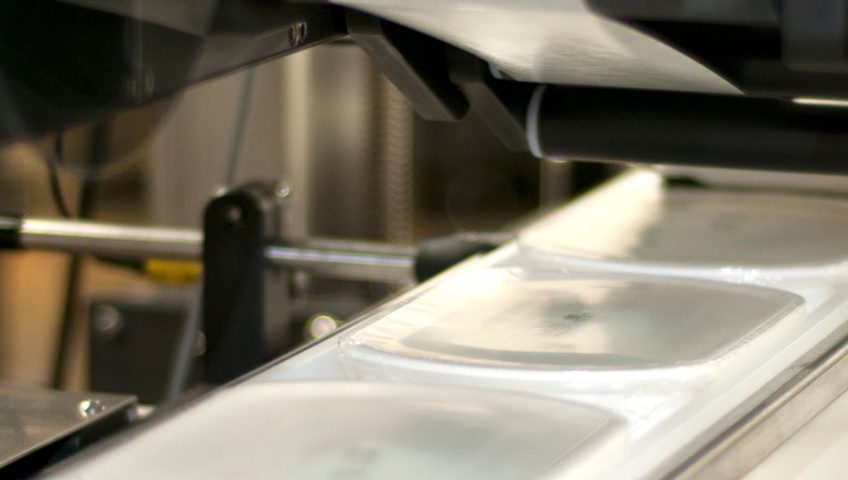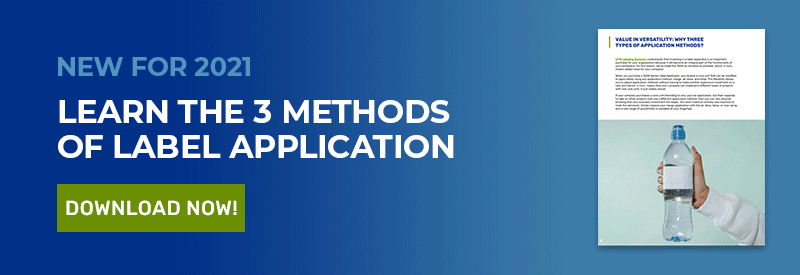
Questions to Ask When Choosing a Commercial Labeling System
In order to shop for a commercial labeling system, you need to understand how it fits your products and your production system. There are many factors to consider, including size, speed, container shapes, printing abilities, and more. Here are some questions you need to answer to understand your labeling needs and find the right equipment for your business.
Which Type of Label Application Should You Use?
What type of label should you use? There are three major technologies for labeling.
Cut and stack labeling applies hot or cold glue to plain paper labels before application. While the labels are low-cost, the equipment can be costly. Most glue application systems only apply adhesive to parts of the label. This lack of coverage makes it easy for the label to get damaged during transit or storage. These labels can’t be applied to surfaces with complex curves, limiting their use on cans and bottles.
Shrink sleeve labeling wraps containers in a plastic film. The container passes through a heat tunnel which shrinks the film and conforms it to the container’s surface. Almost the entire container can be covered, maximizing space for graphics and information. This allows total coverage of odd-shaped containers, but fine-tuning the heating method for a good fit can be costly. Likewise, label design may be more expensive to prevent the shrinkage of text, graphics, and barcodes. Materials and application costs are high, so this method is usually only cost-effective for large production runs. Shrink labels also require some form of climate control during storage. Even a warm summer’s day can be enough to shrink the labels, causing application problems.
Pressure-sensitive labeling is the most popular commercial labeling solution today and has a massive lead over other technologies in the food industry. There is a huge selection of adhesives, label stock, prints, and coatings available to tailor these labels to any application. These labels can be difficult to apply on complex curves, but they work well everywhere else. For most small and medium-sized businesses, pressure-sensitive labels are the most cost-effective labeling method. Machines can be set up to apply multiple labels, allowing for separate front and back labels, bottle neck labels, and more.
What Types of Containers Are You Labeling?
Much of your labeling machine’s design is dictated by your containers. Consider how containers are transported on the machine and what is needed to place the labels. Answering these questions will help you narrow down your choices.
What shape is the container? Is the container shape consistent, or does it vary from product to product? This determines which mechanisms are used to get labels onto containers.
What environments will your product experience? Will it be refrigerated or frozen? Will it be exposed to sunlight or moisture? You may need to choose label materials that can withstand UV light, extreme temperatures, or moisture.
Are your containers fragile? If you’re labeling glass bottles, you need a machine that won’t let these bottles fall during transport or application. If you’re labeling thin cartons, your labeler must apply a label without crushing the product.
Do you need to print information onto the label for each container? If so, you should get a print and apply labeler. How many labels do you need on each container? Machines can be set up to wrap labels around containers, place labels on different faces, and even add labels that prevent tampering.
Making Sure Your Labeling Equipment Works With Your Production Environment
There’s more to production compatibility than high speed. Several factors play a part in ensuring your new labeling equipment integrates with your manufacturing system.
Do you have specific sanitation requirements? For example, you may need to eliminate the chance of paint flakes entering products. In some circumstances, you may need a machine with bare stainless steel components.
How do you establish connectivity between the labeling machine and your operating technology system? There are several standards available, including RS-232, Bluetooth, and Ethernet.
How many types of containers do you need to label? While you can’t use a single machine to label different shapes of containers, most industrial label machines can handle multiple container sizes. For example, bottle labeling machines usually accommodate several size standards. For example, this makes it easier to switch between 750 mL and 375mL wine bottles or from stubby to long neck 12 oz. bottles.
How much space does your facility have? Can you fit a labeler with all the features you need in the space without affecting your production line? Can you only accommodate a tabletop labeler? Which direction does the labeler need to face? Most labeling machines have the option of left or right-handed configuration. This changes which way the machine faces while it’s in operation and can affect access for maintenance and label roll changes.
What power sources are available? While most machines only use 120-volt power, you may need compressed air to run features like label blowers. Some machines also offer 208 and 240-volt power options, so you can use your existing electrical infrastructure.
Choosing a Print and Apply System
Print and apply labelers use a print engine to add text and graphics to labels before they’re applied to containers. This is useful for adding container-specific information, like shipping addresses and use-by dates. Industrial print engines use two methods to print on labels: direct thermal and thermal transfer.
Direct thermal printing uses heat to darken thermal paper. Due to its temporary nature, direct thermal printing is best for short-term applications like shipping labels.
Thermal transfer printing uses heat to melt ink onto the label. This works with any label material that can absorb ink, and the results are permanent. Ink ribbons need to be replaced as they’re used up, increasing maintenance.
Label Application Methods
Where do you need product labels to go on your containers? The size, shape, and strength determine the best way to apply each label. There are 3 main application methods used by labeling machines. Each method is suited to a few specific applications.
- Merge: This is also known as “wipe-on” application. The label is “merged” onto the product as it travels past the peel edge of the label applicator. This works well for flat and even surfaces, or rounded surfaces like bottles.
- Air-Blow: A pneumatic system pushes the label onto the container using a burst of air. This is good for applying labels to fragile products, uneven surfaces, and soft surfaces because there is no direct contact between the applicator and the product.
- Tamp: A vacuum holds the label in place and an air cylinder uses compressed air to blow the label onto the product with no direct contact. Unlike air-blow application, the tamp applicator’s air cylinder allows for a longer distance between the applicator and the label position. This method is great for products with recessed areas.
Most of our machines are compatible with several types of applicators. We also make custom systems designed to address problems encountered in common use cases, like labeling large industrial pails or wine bottles.
We Make It Easy to Set Up New Labeling Equipment
Overwhelmed by the choices you need to make for your new commercial labeling system? Talk to the experts at CTM Labeling Systems. We have local distributors that will work with you to create a labeling solution that addresses a wide variety of applications.





